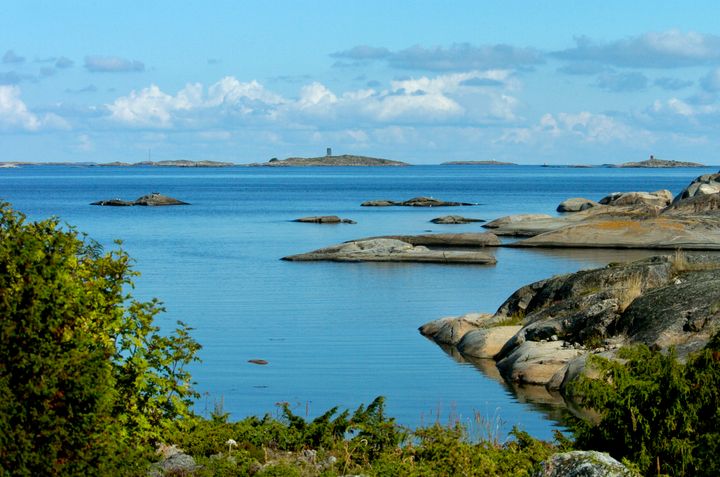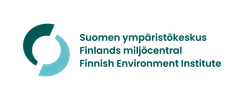A calm start for the blue-green algae season
As typical in early summer, the number of blue-green algae observations is moderate. Some blue-green algae have been observed in inland waters, mainly in Southern Finland. In coastal areas, even slightly less blue-green algae have been detected than typical this time of year. So far, no significant deposits of algae have been observed in offshore areas.

Link to the map
Map of the national blue-green algae monitoring observations on week 25
The blue-green algae situation in inland waters is calm, as typical in early summer. Abundant blue-green algae have been observed at two inland water observation sites of the national blue-green algae monitoring. Some blue-green algae have been observed at 15 inland water observation sites. During the past week, blue-green algae observations have mostly been made in Southern Finland, but also in Central Finland and a single observation in southern Lapland. National blue-green algae monitoring has 246 active inland water observation sites.
In coastal areas, blue-green algae observations are slightly fewer than is typical in early summer. No abundant algae have been observed at the coastal observation sites of the national blue-green algae monitoring, during the past week. Some blue-green algae have been observed at two coastal observation sites. National blue-green algae monitoring has 69 active marine area observation sites.
In offshore areas, the situation is normal for the time period. This week, unstable weather has prevented comprehensive satellite observations in the northern Baltic Sea. Small amounts of blue-green algae mixed with water have been observed in the Gulf of Finland. No blue-green algae have been observed in the Bothnian Sea, the Archipelago Sea and the Åland Sea.
At this time of summer, pollen from coniferous trees may also occur in the water, and it may resemble blue-green algae.
In addition to official monitoring, valuable information on the blue-green algae situation is also gathered from the public. A total of 38 observations made by citizens were obtained through the Lake-seawiki and Vesi.fi, this week.
Syke observes the cyanobacteria occurrence as part of the monitoring of the state of the environment in Finland
The national cyanobacterial monitoring is carried out as part of the monitoring of the state of the environment in cooperation with the Centres for Economic Development, Transport and the Environment, municipal environmental and health authorities, and the Finnish Environment Institute (Syke). Finnish Rotary Clubs are also actively involved in nationwide cyanobacterial monitoring.
The cyanobacterial monitoring is based on the monitoring of cyanobacterial deposits in surface water. The intention is to provide an overview of the cyanobacterial situation in different water bodies. The monitoring includes about 400 permanent observation sites across the country on inland and coastal waters and in the archipelago.
Information on the cyanobacterial situation in the open sea areas is mainly obtained from satellite images, but also from the Finnish Border Guard, the marine research vessel Aranda, the optical device located at the Utö Atmospheric and Marine Research Station, as well as cruise and merchant ships (MS Finnmaid and MS Silja Serenade) equipped with Alg@line measuring equipment. The drift forecasts for cyanobacterial rafts in open sea areas are prepared in cooperation with the Finnish Meteorological Institute's Maritime Services.
Syke reports on the national cyanobacterial situation on a weekly basis every Thursday from 19 June to 7 August 2024. The weekly algal reporting was launched in 1998.
Several compounds produced by cyanobacteria can cause health hazards
According to the Finnish Institute for Health and Welfare (THL), cyanobacterial occurrences can cause health hazards. Cyanobacteria produce a number of different compounds that can cause symptoms. Some cyanobacteria can produce liver or nerve toxins, but most of the symptoms experienced by swimmers may also be due to other compounds.
Small children and pets should particularly be kept out of water rich with cyanobacteria. Water with cyanobacteria should not be used in a sauna or as washing or irrigation water.
If you suspect a poisoning, seek medical advice, or take the pet to a veterinarian. If necessary, the Poison Information Centre will provide additional instructions.
The municipal health authorities monitor the cyanobacterial situation on beaches.
More information about blue-green algae and health:
- At the the Finnish Institute for Health and Welfare (THL) website
- At the Poison Information Center website
This is how you identify cyanobacteria
A small amount of cyanobacteria in the water appears as green or yellowish particles. Narrow stripes of algae can drift to a beach. In calm weather, a substantial amount of cyanobacteria forms greenish or yellowish algal rafts and piles up in coastal water. In spring, yellowish pollen from coniferous trees may also be present in the water. Unlike cyanobacteria, pollen is found not only on the surface water but also, for example, on piers or yard furniture.
Cyanobacteria dissolve into tiny particles in the water if you touch the algal mass with a stick. If the algae become attached to the stick, they are something other than cyanobacteria. In a water vessel, cyanobacteria rise to the surface as tiny greenish particles within about an hour.
- Read more: How do you recognize blue-green algae?
Report your cyanobacterial observations to the Järvi-meriwiki (Lake and sea wiki)
In Järvi-meriwiki, maintained by the Finnish Environment Institute, you can establish your own observation site and share cyanobacterial observations or make individual observations when moving around waterways. You can also report observations via the smartphone-friendly Havaintolähetti website.
The reported observations are shown on the national cyanobacterial observation map, and they support the national algal situation assessment. Observations about the absence of cyanobacteria are also important.
Järvi-meriwiki is an online service produced in collaboration with authorities and citizens. The service provides basic information on all lakes larger than one hectare as well as different areas of the Baltic Sea. Users can share, for example, photos and other observations on the service.
Municipalities and cities monitor the cyanobacterial situation on the beaches, so it is advisable to report rich cyanobacterial occurrences on beaches to the health authorities of the municipality in question.
Cyanobacterial observations also in the MarineFinland.fi and Waterinfo.fi services
The cyanobacterial maps presented on the websites MarineFinland.fi and Waterinfo.fi combine the observations reported to the Järvi-meriwiki and from the beaches of the City of Helsinki, as well as the observations based on satellite interpretations made by Syke during the last three days.
Keywords
Contacts
Communications:
Vilma Rikala, firstname.lastname@syke.fi, Tel. +358 295 251 085
Inquiries about blue-green algae situationTelephone 1 pm to 3 pm
Lakes: Tel +358 50 5734 347 or +358 295 251 326
State of the Baltic Sea: Tel +358 50 5693 297 or +358 295 251 314
Satellite observations: Tel 358 50 4707 576 or +358 295 251 329, e-mail: Eotuki@syke.fi
Media service at Finnish Environment Institute
Our Media Service provides information on research, helps journalists find experts for interviews and provides photos for media use.
Our Communication experts will answer your inquiries on weekdays from 9 am to 4 pm.
Links
Finnish Environment Institute - We build hope through research.
Finnish Environment Institute
Latokartanonkaari 11
00790 Helsinki
+358 295 251 000
It is time to move beyond solving environmental problems one by one, to systemic sustainability transformations. The Finnish Environment Institute (Syke) contributes to building a sustainable society through research, information and services. The Finnish Environment Institute is a research institute with 700 experts and researchers located in Helsinki, Oulu, Jyväskylä and Joensuu.

Subscribe to releases from Suomen ympäristökeskus
Subscribe to all the latest releases from Suomen ympäristökeskus by registering your e-mail address below. You can unsubscribe at any time.
Latest releases from Suomen ympäristökeskus
Lugn början på cyanobakteriesäsongen19.6.2025 13:14:48 EEST | Pressmeddelande
Antalet observationer av cyanobakterier är måttligt, vilket är typiskt för början av sommaren. Lite cyanobakterier har påträffats på sina håll i insjöar, främst i Södra Finland. I kustområdena har cyanobakterier observerats i något mindre utsträckning än vad som är vanligt för den här tiden på året. Hittills har inga större mängder cyanobakterier observerats på öppna havsområden.
Rauhallinen alku sinileväkaudelle19.6.2025 13:00:00 EEST | Tiedote
Sinilevähavaintojen määrä on alkukesälle tyypilliseen tapaan maltillinen. Sisävesillä on paikoittain havaittu hieman sinilevää, pääosin Etelä-Suomessa. Rannikkoalueilla sinilevää on havaittu ajankohtaan nähden jopa hieman vähemmän. Avomerialueilla ei ole toistaiseksi havaittu merkittäviä leväesiintymiä.
Lajistoseurantojen merkitys korostumassa: suomalaisen luontotiedon tuotanto vapaaehtoisten varassa17.6.2025 10:12:54 EEST | Tiedote
Suomen luonnon tilaa valottavista lajistoseurannoista on koottu ensimmäistä kertaa kattava kokonaiskuva. Kysyntä seurantojen tuottamille tiedoille kasvaa tulevaisuudessa entisestään. Vapaaehtoistyö on seurannoille valtava voimavara, mutta rahoituksen epävarmuus uhkaa seurantatyön jatkuvuutta.
Suomen ympäristökeskukselta kolme merkittävää sitoumusta merten suojelemiseksi13.6.2025 17:37:32 EEST | Tiedote
Suomen ympäristökeskus (Syke) on tehnyt osana vuoden 2025 YK:n valtamerikonferenssia kolme sitoumusta, jotka tukevat tutkimukseen perustuvaa päätöksentekoa Itämeren ympäristön hallinnassa ja suojelussa. YK:n valtamerikonferenssi on pidetty kuluneella viikolla (9.–13.6.2025) Nizzassa, Ranskassa. Konferenssin tavoitteena on nopeuttaa ja lisätä merten suojeluun ja kestävään käyttöön tähtääviä toimia.
Finnish Environment Institute presents three commitments to safeguard ocean and seas13.6.2025 17:02:41 EEST | Press release
As a part of the 2025 United Nations Ocean Conference, the Finnish Environment Institute (Syke) has made three commitments to support science-based decision-making in management and protection of the Baltic Sea environment. The high-level 2025 United Nations Ocean Conference has been held in Nice, France, 9–13 June 2025. The conference aims at accelerating measures and mobilizing all actors to conserve and use the ocean in a sustainable way.
In our pressroom you can read all our latest releases, find our press contacts, images, documents and other relevant information about us.
Visit our pressroom